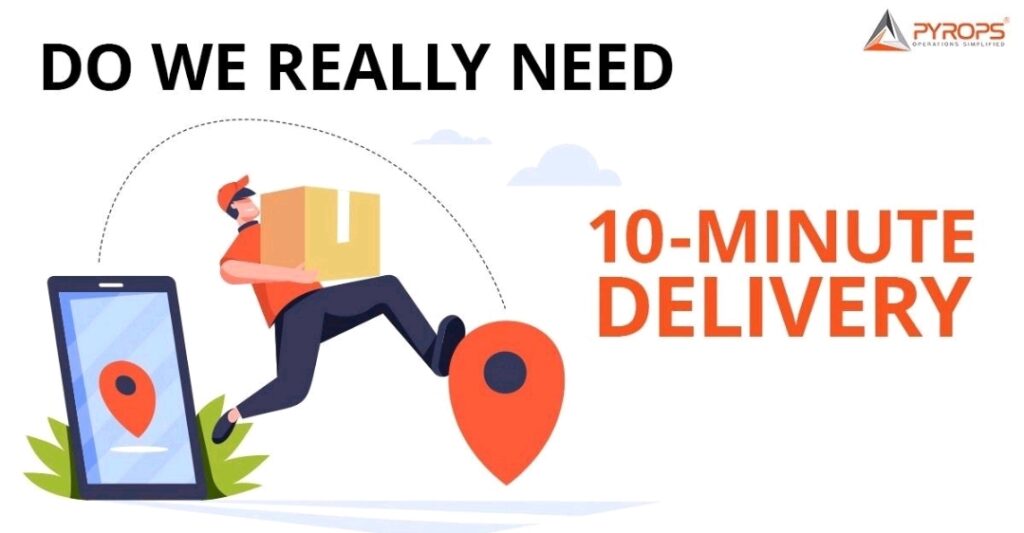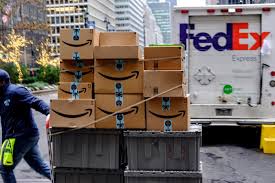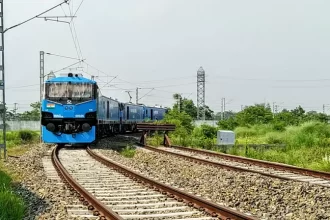Market dynamics are forcing e-commerce companies to constantly evolve and undercut each other. Companies are competing not only on pricing and quality but also on how fast they reach your doorstep i.e 10-minute delivery.
The pandemic played a pivotal role in catapulting premier online grocery shopping services into the mainstream, transforming a significant portion of the $2 trillion global grocery market. As a result of widespread preference for grocery delivery services during the pandemic, industry leaders and emerging players are now delving into a burgeoning sector known as quick commerce or q-commerce. The integration of warehouse management systems (WMS) solutions has become a key enabler in this evolution. The market penetration of quick-commerce, with the aid of WMS solutions, reached an estimated $0.3 billion in 2021, and projections indicate substantial growth to $5 billion by 2025 in India.
Quick commerce startups, commonly referred to as 10-minute delivery apps, empower customers to conveniently order groceries and essential items through their mobile phones. These products are housed in dark stores, compact warehouses strategically positioned across urban areas. Utilizing warehouse management system software, these startups efficiently manage inventory and logistics. However, towards the end of 2022, these quick commerce ventures encountered significant challenges, including substantial financial losses, insufficient funding, and heightened competition. Consequently, they had to streamline operations, downsize their workforce, and shutter dark stores.
Numerous startups, ranging from major players to smaller entities, are swiftly entering the realm of q-commerce. A significant shake-up has occurred in the grocery delivery sector with the emergence of Zepto, a new entrant that employs a 10-minute grocery home delivery service. Blinkit, formerly known as Grofers, has initiated 10-minute grocery delivery in multiple cities. Swiggy has introduced Instamart, committing to a delivery timeframe of 20-30 minutes. Dunzo has rolled out Dunzo Daily, and Ola is in the early stages of testing rapid grocery delivery in Bengaluru, showcasing the industry’s dynamic landscape driven by warehouse management software.
Who needs 10-minute delivery?
Shifting to digital platforms to promote cashless transactions, the world has gone through extreme ramifications that now appear to be promoting a permanent behavioral shift.
India’s retail market is huge: $800 billion. And it’s dominated by the 11 million Kirana shops!! One can get all things from nearby Kirana shops. So why should one order online? More importantly – who needs 10-minute delivery and is there a real business use case here?
To answer this, let’s understand how we are wired as humans. Humans optimize for time naturally, regardless of whether there is an urgency or not. In general, we tend to optimize for time if there is a way to accomplish something in less time.
To this extent – whether consumers ‘need’ delivery services near– is a moot question. If two companies are offering the same products at the same prices, we will naturally choose the one which services in less time.
Having said that – quick commerce is more relevant for unplanned buys, impulse or emergency purchases but whether 10-minute delivery is feasible as a business model is a completely different discussion that requires delving into the economics of best grocery online.
Is 10-minute delivery the next big thing in the warehouse management system?
Speed delivery with warehouse management system
According to Supply Chain Dive, as the industry approaches its peak season, supply chain leaders will confront fresh challenges attributable to expansion. Although this season is poised to establish new benchmarks, growth rates are not anticipated to surpass those observed in 2018. Nonetheless, escalating and distinctive customer demands persist, and any oversight in preparing for heightened demand, particularly within systems of record, will not be excused. It is imperative for supply chain leaders to comprehend the potential repercussions of failures in the warehouse management system (WMS) on customer experiences and operational efficiency. Additionally, adopting a set of best practices is crucial to enhance the speed of fulfillment and delivery during the peak season and beyond.
How to Use a WMS to Increase Delivery Speed
Using a Warehouse Management System (WMS) can really speed up deliveries and make things run more smoothly. WMS lets you see what’s in stock in real-time, making it easier to manage orders. It automates tasks like picking, packing, and shipping, which reduces mistakes and makes the whole order process faster. Keeping track of inventory efficiently ensures that products are ready to ship, cutting down on delays. WMS also gives you data and reports to find any issues in your supply chain and improve them. If you add technologies like barcode scanning and RFID tracking, it makes handling goods even quicker. So, by making the most out of a WMS, businesses can handle busy times better and meet customer expectations with faster and more accurate deliveries.
Many startups are considering using dark stores in their supply chain delivery.
How does 10-minute delivery work?
Let’s first understand how 10-minute delivery works as a concept.
Mini Warehouses or Dark Stores
To deliver items in 10 minutes, warehouses need to be closer to people’s homes. That’s why these quick delivery apps create lots of mini-warehouses or dark stores in every city.
Dark stores or micro-warehouses are located close to the point of delivery. Each dark store manages a focused set of 2,000-2500 stock-keeping units (SKUs) or distinct product items. Startups are using Technologies inside these dark stores to reduce the processing time for orders.
Dark stores, also known as micro-fulfillment centers (MFCs), are small, hyper-localized warehouses that store products for online orders. They are typically located in densely populated areas, and customers cannot visit them in person. Instead, customers order products through a mobile app, and dark store employees pick and pack the orders for delivery. Dark stores are much smaller than traditional e-commerce warehouses, typically occupying only 2,000 to 5,000 square feet. Dark stores need automation, good locations, smart design, and efficient order pickers to be successful. Their layouts are different from retail stores and warehouses because they are only used to fulfill orders quickly with quick delivery apps.
For example, Blinkit (formerly Grofers) has lots of mini-warehouses within 2kms of people’s homes. Their stores are so densely located that they can deliver 90% of their orders within 15 minutes even if their riders drive at 10kmph. Their in-store planning and tech are now so good that they pack most orders in under 2.5 minutes. Dunzo has a chain of mini-warehouses called Xpress Mart located within 5kms of people’s homes. Swiggy’s Instamart and Zepto also follow the same strategy.
Limited SKUs
Best online grocery store has brought a big shift in the mindset of grocery e-commerce players.
Earlier, they were following the supermarket strategy: They kept lots of SKUs in the warehouses to give more choices to customers. But it resulted in slow delivery.
Now they have changed their strategy to the Kirana shop strategy. They have mini-warehouses, and they keep limited inventory in these warehouses. Sure, limited inventory means fewer choices for customers, but an assortment of 2000-2500 sizes covers the most essentials and fast-moving items. Once an order is placed, it is picked and packed within 1.5-2.5 minutes to allow for sufficient time for delivery within the stipulated 10 mins.
About 10-minute delivery – Business model
Quick commerce dark stores carry 15-20% of the assortment needed in typical households.
The typical average order value is ~350-400.
This business can only make sense if there are a lot of orders being generated in a high-density customer cluster based on a limited catalogue. If this happens – then there can be the hope of optimizing the delivery costs and preserving margins.
How to optimize the preparation of goods delivery with WMS?
To make goods delivery smoother and faster with a Warehouse Management System (WMS), you can use its cool features. First off, WMS helps you see what’s in stock right away, so you can plan better. It automates tasks like picking, packing, and shipping, which makes things quicker and cuts down on mistakes. Keeping inventory organized and easy to find means less time wasted getting things ready. WMS also gives you data and trends to predict what you’ll need and keep the right amount of stock. If you add things like barcode scanning and RFID tracking, it makes identifying goods more accurate and speeds up the whole process. So, by using WMS well, businesses can make their delivery process more efficient, cutting down on prep time and making sure things get delivered on time.
How can businesses make 10-minute delivery profitable?
Traditional online distribution is generally not highly profitable. Therefore, in the initial years, achieving profitability with a 10 minutes delivery app can be challenging. Here are two approaches to enhance the profitability of 10-minute delivery for grocery shopping delivery services.
Scale – To make money, online delivery companies need to scale up operations by attracting more customers to order online. This can be done through incentives like discounts and free delivery. Once they have a large enough customer base, they can start to generate more revenue than expenses and become profitable.
Subscription To Groceries – 10-minute delivery companies can increase revenue and gain loyal customers by offering a “subscribe to groceries” feature in their app. This would allow customers to receive the best grocery online at their doorstep at regular intervals, such as daily or weekly. This would be beneficial for both customers and delivery companies.
Our verdict
A 10-minute value proposition won’t hold for long. Once investors start to limit the funding of losses, this will become compromised. Once compromised, the quick commerce players will have to increase assortment (to increase average order value). It thereby requires larger warehouses, in turn increasing the serviceability radius. As soon as the serviceability radius increases – one can no longer promise or honor the 10-minute deliveries.







